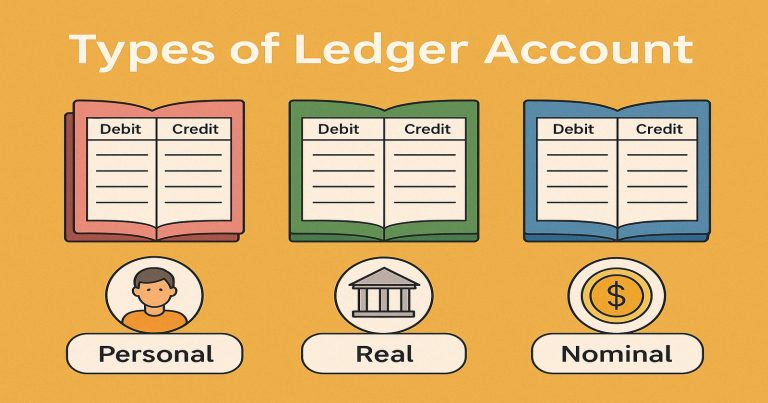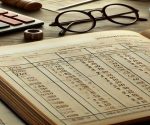Different types of ledger accounts are used in accounting to structure financial data in an understandable manner. A ledger is a compilation of all the transactions of a business. The ledger average account has its own space, where all the transactions involved with that account are written. It is crucial for both students and businesses to understand the types of ledger accounts. These ledger types display who paid what, where money was used, and how business made or spent money. These accounts make it simpler to prepare financial statements.
What Is a Ledger Account?
A ledger account shows how it has changed over time (month by month, probably). It maintains a record of debits and credits per account. It is the core part of the double-entry ledger example system used by businesses the world over. In this section, you will understand what is a ledger account, why it is used, and its format. Types of ledger accounts and the role of ledgers in financial statements Knowledge of the ledger account meaning is the first step towards basic accounting
Types of Ledger Accounts
A ledger account is like a diary in which a business records each financial activity in different account headings. The ledger, which comes after journal entries, is the second step in the accounting process and summarizes all transactions by account.
Ledger accounts can be grouped into three broad categories:
- Personal Accounts
- Real Accounts
- Nominal Accounts
These types are based on basic tenets of accounting. They all have a different purpose and operate under other rules. We will understand all these ledger accounts one by one with their definitions, relevant examples, and real-life applications in the following sections.
Personal Accounts
Personal account is used for recording transactions between an individual or an organization. It tracks what you owe others and what others owe you. These accounts are entities, individuals, companies, and organizations.
Subtypes of Personal Accounts are:-:
- Natural Persons – Actual human beings Ram, Shyam, or Anita.
- Artificial Persons – like Businesses or institutions e.g. Infosys Ltd., ICICI Bank
- Representative Persons – Accounts that represents for a class of person or expense like “Outstanding Rent A/c” or “Prepaid Salary A/c”.
Rule of Personal Accounts:
Debit the Receiver accounts are credit the Giver
Example
If you pay ₹1,000 to a vendor named Rahul:
The balance in Rahul’s account will be credited. Cash account will be debited.
Journal Entry:
Rahul A/c Dr. ₹1,000
To Cash A/c ₹1,000
In Ledger:
Rahul Account
| Date | Particulars | Amount (Cr) |
| 01 Apr | Cash A/c | ₹1,000 |
This account shows you paid Rahul ₹1,000. That’s how personal accounts operate in a ledger in accounting.
Real Accounts
Assets of a business are dealt with a real account. These assets can either be tangible (can touch) or intangible (cannot touch). Real accounts are accounts that show what the business owns and are used to prepare the balance sheet.
Types of Real Accounts
- Tangible Assets – Physical assets such as furniture, currency, machines, land, etc.
- Intangible Assets – Assets that you cannot touch, such as goodwill, trademarks, and patents.
Rule of Real Accounts
What Comes In Debit, What goes Out Credit
Example
A company purchases a machine worth ₹50,000 for cash.
Machinery Account is debited. The cash account is credited.
Journal Entry:
Machinery A/c Dr. ₹50,000
To Cash A/c ₹50,000
Ledger Posting:
Machinery Account
| Date | Particulars | Amount (Dr) |
| 10 Apr | Cash A/c | ₹50,000 |
Key Real Accounts:
- Cash Account
- Land & Building Account
- Furniture Account
- Machinery Account
- Goodwill Account
Real accounts are permanent. They roll over balances from year to year.
Nominal Accounts
Nominal account is an account in which incomes, gains, expenses and losses are being recorded. These accounts are temporary. At the end of the accounting year, they reset to zero. Nominal accounts82The capital or the ownership987The balance of nominal accounts is transferred to the Profit and Loss Account
Rule of Nominal Accounts
Debit all expenses and losses Credit all incomes and gains
Examples of Nominal Accounts:
| Expenses and Losses (Debit) | Incomes and Gains (Credit) |
| Rent Account | Commission Received A/c |
| Salary Account | Interest Received A/c |
| Loss by Fire Account | Profit on Sale of Asset A/c |
Example
If the rent paid by the company is ₹5000:
Journal Entry:
Rent A/c Dr. ₹5,000
To Cash A/c ₹5,000
Ledger Posting:
Rent Account
| Date | Particulars | Amount (Dr) |
| 05 May | Cash A/c | ₹5,000 |
These accounts show how, and how much, the business earns and spends. These accounts are closed at the end of the year to find out net profit or loss.
| Feature | Personal Account | Real Account | Nominal Account |
| Nature | Deals with persons/parties | Deals with assets | Deals with incomes and expenses |
| Permanent or Not | May be temporary or ongoing | Permanent | Temporary (closed yearly) |
| Rule | Debit the receiver, credit the giver | Debit what comes in, credit what goes out | Debit expenses/losses, credit incomes/gains |
| Examples | Ram’s A/c, Bank A/c | Cash A/c, Furniture A/c | Rent A/c, Salary A/c, Sales A/c |
| Financial Statement | Balance Sheet & Trial Balance | Balance Sheet | Profit and Loss Statement |
Importance of These Types of Ledger Accounts
The types of ledger accounts helps a business to maintain eases everything about his money. It also keeps the accounting correct, and useful for audits. Based on accounts to ledger format, companies prepare their financial reports for historical records and legal purposes.
Each type of each account also supports the double entries, where every debit has its respective credit. Each type serves a unique purpose in the summary of financial data.
Accounting of Ledger Accounts
In accounting, we segregate ledger accounts to get better information. Ledger accounts can be categorized according to their nature. This reorganization makes it easier to find and update and use them. Let’s explore this in detail.
Based on Nature
On the basis of the above, we could classify the ledger account into the following three types:
- Personal
- Real
- Nominal
Also referred to as the golden rule of accounting. Every account belongs to one of these types.
In this type of collection, a company can easily verify who owes what (personal), what it actually possesses (real), and what it actually manufactures or uses (nominal).
For instance:
| Account Name | Type |
| Amit’s A/c | Personal |
| Cash A/c | Real |
| Rent A/c | Nominal |
Based on Function
Some companies also divide ledgers by what the account is used for.
- Sales Ledger – Records all sales made to customers on credit.
- Purchase Ledger – Records credit purchases made from suppliers.
- General Ledger – All other accounts (Expenses, Incomes, Assets, Liabilities, etc)
All the financial statements are prepared using general ledger accounts. It is recorded into these accounts when a company journals transactions into ledgers. In accounting, we refer to this process as ledger posting.
For example: The sales ledger tells us about the money to be received from customers.
- The purchase ledger shows the amount owed to suppliers.
- The General Ledger consolidates all other accounts together.
This functional encompassing classification aids firms in monitoring every financial movement with utmost transparency. It means, for example, that companies can easily see how much they need to pay or receive and what they own or owe.
Ledger Accounts Examples and Format
Each ledger account has a very basic T-shape design. It consists of two sides: debit (left) and credit (right). Double indicators for each informational category must be in both directions because accounting uses the double entry system. Now, Let us make examples for the ledger accounts format.
Format of Ledger Account
At the Ledgers: (here is the common format)
| Date | Particulars | J.F. | Amount (Dr) | Date | Particulars | J.F. | Amount (Cr) |
- “Dr” stands for Debit side
- “Cr” stands for Credit side
- “J.F.” stands for Journal Folio — it connects the ledger to the journal
Journal Entry Example and Ledger Posting
Let’s consider a journal entry as an example and demonstrate how it shows up into the ledger.
Journal Entry:
01 Jan: Cash A/c Dr ₹5,000
To Capital A/c ₹5,000
Ledger Posting:
Cash Account
| Date | Particulars | J.F. | Amount (Dr) | Date | Particulars | J.F. | Amount (Cr) |
| 01 Jan | Capital A/c | 101 | ₹5,000 |
Capital Account
| Date | Particulars | J.F. | Amount (Dr) | Date | Particulars | J.F. | Amount (Cr) |
| 01 Jan | Cash A/c | 101 | ₹5,000 |
Difference Between Journal and Ledger with Example
The journal is where the transaction is initially recorded, and the ledger is where it gets posted under each individual account.
- All ledger accounts follow the same ledger accounts format. Being in a standard format, it makes it easier to prepare the trial balance, profit and loss account and balance sheet.
- A ledger in a business can contain hundreds of accounts. The individual accounts help in knowing the exact location of assets expenses, incomes, and liabilities.
- Through ledger in accounting, companies make a clear image of their real financial situation at any moment. Hence, understanding the types of ledger accounts and their format is extremely crucial.
Relevance to ACCA Syllabus
Ledger accounts are the basis of double-entry bookkeeping that is greatly examined under ACCA subjects such as Financial Accounting (FA) and Financial Reporting (FR). Understanding the difference between real nominal and personal accounts is beneficial for ACCA students in recording journal entries, preparing trial balances with accuracy, and ultimately able to prepare the financial statements as per international accounting standards (IFRS).
Types of Ledger Accounts ACCA Questions
Q1 Which is NOT a nominal account?
A) Building Account
B) Capital Account
C) Wages Account
D) Bank Account
Ans: C) Wages Account
Q2: In terms of ledger accounts, the Purchases Account is which type?
A) Real Account
B) Personal Account
C) Liability Account
D) Nominal Account
Ans: D) Nominal Account
Q3: An account in the ledger maintained for a customer is a:
A) Real Account
B) Personal Account
C) Nominal Account
D) Suspense Account
Ans: B) Personal Account
Q4: Which of the following is a real account in the general ledger?
A) Rent Expense
B) Cash
C) Commission Earned
D) Salaries Payable
Ans: B) Cash
Q5: What is the account where we record the goods purchased for resale:
A) Sales Account
B) Capital Account
C) Purchases Account
D) Interest Account
Ans: C) Purchases Account
Relevance to CMA Syllabus
The importance of knowing how to record financial transactions in their required ledger accounts is something that candidates for the US CMA (Certified Management Accountant) exam must understand as they prepare for Part 1: Financial Planning, Performance, and Analytics of the test. Real, nominal and personal accounts help in maintaining financial control, conducting reconciliation processes, and performing analysis, which are key aspects of managerial decision-making.
Types of Ledger Accounts CMA Questions
Q1: What type of ledger account contains items like machinery and equipment?
A) Nominal
B) Personal
C) Real
D) Liability
Ans: C) Real
Question 2: Which of the following is not a nominal account?
A) Rent Expense
B) Salaries Expense
C) Utilities Expense
D) Accounts Payable
Ans: D) Accounts Payable
Q3: The sales earned during a period are recorded in:
A) Real Account
B) Liability Account
C) Personal Account
D) Nominal Account
Ans: D) Nominal Account
Q4: Personal ledger account can be any of the following account?
A) Furniture Account
B) Capital Account
C) Cash Account
D) Debtor’s Account
Ans: D) Debtor’s Account
Q5: The Wages Account is a part of what financial statement?
A) Balance Sheet only
B) Cash Flow only
C) Profit & Loss Account
D) Statement of Equity
Ans: C) Profit & Loss Account
Relevance to US CPA Syllabus
Classification of ledger accounts is critical in the US CPA exam, especially the FAR(Financial Accounting and Reporting) section. Adjusting entries, preparation of financial statements, and permanent vs temporary accounts are impacted by ledger account types (real, nominal, and personal). These are all skills that are required under both US GAAP and IFRS.
Types of Ledger Accounts US CPA Questions
Q1: Which of the following account is temporary (nominal) account?
A) Retained Earnings
B) Cash
C) Utilities Expense
D) Accounts Receivable
Ans: C) Utilities Expense
Q2: What account shows a personal ledger account?
A) Inventory
B) Sales
C) John Smith – Debtor
D) Plant & Machinery
Ans: C) John Smith – Debtor
Q3: Land shown in the books falls in the category of:
A) Real Account
B) Nominal Account
C) Revenue Account
D) Personal Account
Ans: A) Real Account
Q4: At year-end, which account the balance of a nominal account is transferred to?
A) Cash
B) Capital
C) Income Summary
D) Retained Earnings
Ans: C) Income Summary
Q5: Which ledger account reflects a company’s obligation?
A) Prepaid Rent
B) Equipment
C) Sales
D) Accounts Payable
Ans: D) Accounts Payable
Relevance to CFA Syllabus
CFA Level I – Financial Reporting and Analysis module covers the entire financial statements, which is based on the accounting that has to do with classification to properly prepare accounts. Understanding the types of ledger accounts (real, nominal or personal accounts) assists candidates in interpreting the impact of transactions on the balance sheet, income statement, and cash flow, especially while analyzing the financial ratios or the company’s performance.
Types of Ledger Accounts CFA Questions
Q1: Which of the following would be reported in the income statement and is a nominal account?
A) Equipment
B) Sales Revenue
C) Accounts Receivable
D) Capital Stock
Ans: B) Sales Revenue
Q2: The balance of which of the following account is not transferred to next accounting year?
A) Accumulated Depreciation
B) Inventory
C) Insurance Expense
D) Accounts Payable
Ans: C) Insurance Expense
Q3: What account is used to record ownership in the company by a particular investor?
A) Cash
B) Equipment
C) Mr. John’s Capital Account
D) Retained Earnings
Ans: C) Capital Account of Mr. John
Q4: Where is an authentic account likely to show up?
A) Income Statement
B) Trial Balance only
C) Balance Sheet
D) Notes to Accounts
Ans: C) Balance Sheet
Q5: Where does the “Office Supplies Expense” belong, which type of account?
A) Real Account
B) Nominal Account
C) Liability Account
D) Personal Account
Ans: B) Nominal Account


